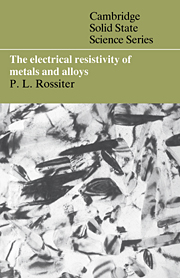Book contents
- Frontmatter
- Contents
- Preface
- 1 Basic concepts
- 2 Atomic configuration of an alloy
- 3 The structure of magnetic materials
- 4 Electrons in simple metals and alloys
- 5 Electrical resistivity of simple metals and alloys
- 6 Non-simple, non-magnetic metals and alloys
- 7 Magnetic and nearly magnetic alloys
- 8 Other phenomena
- Appendices
- References
- Index
7 - Magnetic and nearly magnetic alloys
Published online by Cambridge University Press: 07 January 2010
- Frontmatter
- Contents
- Preface
- 1 Basic concepts
- 2 Atomic configuration of an alloy
- 3 The structure of magnetic materials
- 4 Electrons in simple metals and alloys
- 5 Electrical resistivity of simple metals and alloys
- 6 Non-simple, non-magnetic metals and alloys
- 7 Magnetic and nearly magnetic alloys
- 8 Other phenomena
- Appendices
- References
- Index
Summary
The structure of magnetic material was discussed in some detail in Chapter 3 and we now want to consider how this magnetic structure effects the motion of conduction electrons. However, the purpose of this chapter is not so much to give a complete theory of the resistivity of magnetic materials but, rather, to alert the reader to some of the complications that can arise when the alloy being investigated is magnetic or nearly magnetic. We will thus concentrate mainly on those aspects of the resistivity of magnetic materials that have a dependence upon composition and atomic correlations. Furthermore, as much of the theory of the magnetic state is still being developed, some of the analysis will of necessity be qualitative rather than quantitative.
Magnetic materials with long range magnetic order
Overview
As noted in Section 3.1, there are still some aspects of the nature of the magnetic state at finite temperatures in transition metals that are uncertain. As such we cannot as yet give a comprehensive discussion about the variation of resistivity with temperature and the effects of alloying. References to some of the more general theories of the resistivity of magnetic materials are given in Table 7.1. We can, however, give a qualitative description by adopting the view that a clear separation is possible between the conduction and magnetic electrons and that they are scattered by deviations from perfect ordering of the magnetic moments.
- Type
- Chapter
- Information
- The Electrical Resistivity of Metals and Alloys , pp. 318 - 355Publisher: Cambridge University PressPrint publication year: 1987



